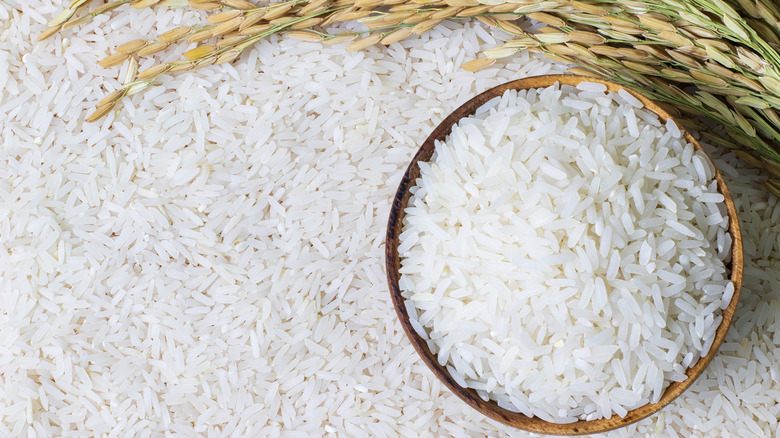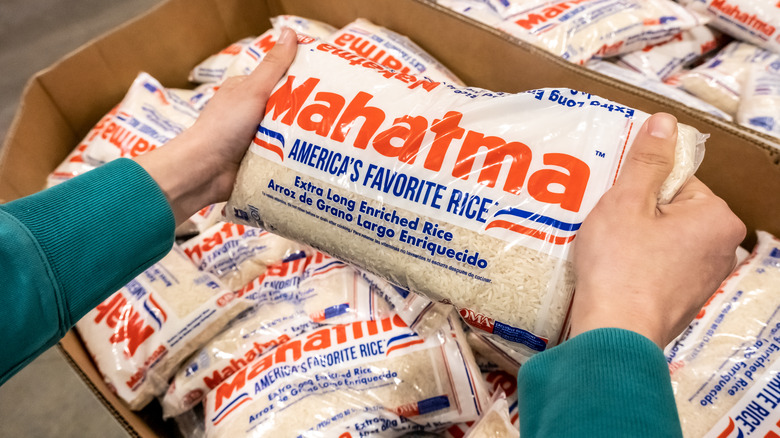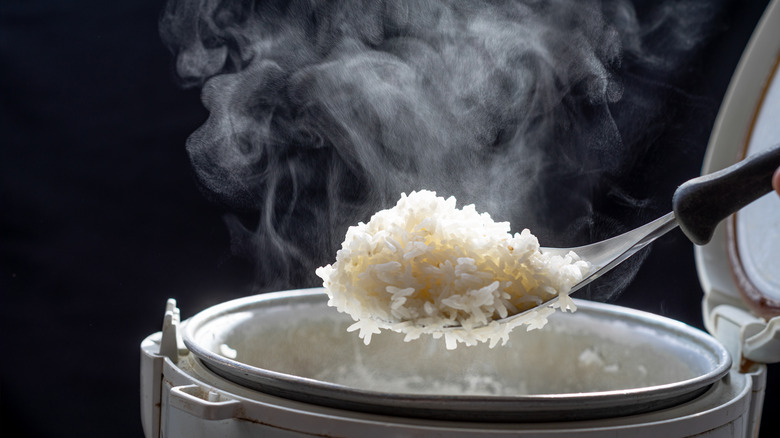Enriched Rice Vs. Regular: What's The Difference?
You are standing in the grocery store aisle, staring at the white rice and deciding what to buy. With jasmine and basmati, long grain, extra-long grain, medium grain, short grain, and even "minute rice" varieties, there are a lot to choose from for a variety of purposes and with various cooking methods. Take a closer look and you may also notice that many packages include the word "enriched." But what does that mean? What makes rice enriched and different from "regular" rice?
According to the U.S. Department of Agriculture, in 100 grams of unenriched white rice there are 7.1 grams of protein and 115 milligrams of potassium, but only 0.8 milligrams of iron, 1.6 milligrams of niacin, .07 milligrams of thiamine, and no folic acid. Not the most nutrient packed food. Some of these totals start to change in enriched rice.
According to SFGate, the flavor and uses of the two kinds of rice may remain the same, but the difference comes down to nutrition, and the impact ... well, one could say it can "enrich" your diet.
What is enriched rice?
The difference between enriched and unenriched white rice begins with the difference between brown and white rice (via MasterClass). Rice is a cereal grain made up of three parts: the bran, the germ, and the endosperm. Brown rice, a whole grain, contains all three making it more nutritionally dense but also slightly tougher, changing the flavor and texture and increasing cooking time.
White rice has had the bran and germ removed, leaving only the carby endosperm. This processing makes the rice softer and easier to cook, but also strips the grain of many beneficial nutrients that are found in the bran and germ.
This is where enriched white rice comes in: as MasterClass writes, enriched means that some of the nutrients, namely thiamine, folic acid, and niacin, have been added back to the processed rice. Brown rice still has the edge in nutritional value, but enriching white rice makes it a better contender for a balanced diet.
How to cook enriched rice
So why should you care if your rice is enriched? The nutrients supplemented in enriched rice do actually make an impact. According to Healthline, beriberi is a disease caused by a deficiency of thiamine (one of the nutrients added to enriched rice) and can result in circulatory or muscle and nerve damage. It's particularly prevalent in countries where rice is a staple part of the everyday diet. With that added thiamine content, using enriched rice rather than regular in your diet is an easy way to decrease risk of the disease if you are at particular risk.
The use of enriched white rice doesn't differ much from that of regular rice. The important thing to remember when preparing enriched rice is to actually not rinse it. Many cooking experts (like those at the Kitchn) suggest washing rice to remove not only dirt and debris but also surface starch in order to achieve a less clumpy pot of rice. This step is still important for regular white rice. However, MasterClass explains that you'll find that bags of enriched rice will not include that step in the preparation instructions. This is because rinsing enriched rice will wash away some of the added nutrients. Be sure to follow the instructions on enriched rice for maximum nutritional potential. Otherwise, use it the same as you would regular white rice. If a recipe requires washing the rice, just be aware that the nutrients will also be washed away.


